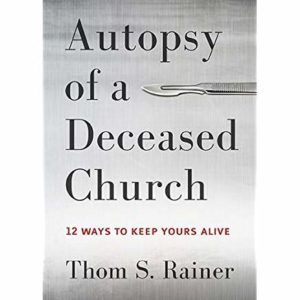 A friend recently lent me a fascinating and reader-friendly book entitled Autopsy of a Deceased Church: 12 Ways to Keep Yours Alive by Thom S. Rainer. Without her recommendation, I would never have picked up this book because the title clearly emphasizes churches that die out. She advised focusing on the subtitle, which, of course, is the opposite emphasis—how to prevent the dieout.
A friend recently lent me a fascinating and reader-friendly book entitled Autopsy of a Deceased Church: 12 Ways to Keep Yours Alive by Thom S. Rainer. Without her recommendation, I would never have picked up this book because the title clearly emphasizes churches that die out. She advised focusing on the subtitle, which, of course, is the opposite emphasis—how to prevent the dieout.
This 2014 book, by the president and CEO of LifeWay Christian Resources, grew out of a desire to understand why so many churches that were once vibrant congregations have in recent years seriously declined and ultimately closed their doors and sold off their properties.
Whether your church is seeing a decline in its numbers of worshippers as the Sundays go by, or is still in the upswing of its church life cycle, this is a book that offers valuable insight into what keeps a church alive. Even though the choir and music ministers are still working hard and serving up beautiful music, even though the pastor still works hard on his/her sermon each week, there may be shifts occurring that don’t bode well for the future.
Rainer writes: “The decline is in the vibrant ministries that once existed. The decline is in the prayer lives of the members who remain. The decline is in the outward focus of the church. The decline is in the connection with the community. The decline is in the hopes and dreams of those who remain.”
That’s a lot of decline, but the problem is that each shift may be subtle and quite easy to overlook, even when it’s building on previous overlooked changes.
“More than any one item,” writes Rainer, “these dying churches focused on their own needs instead of others. They looked inwardly instead of outwardly. Their highest priorities were the way they’ve always done it, and that which made them the most comfortable.”
Two fundamentals of critical importance are meaningful prayer (both individual and corporate), and actively caring for the surrounding community. No matter whether the church is on the upswing or the downswing, these two fundamentals make all the difference in whether the church is Christ-centered, likely to remain strong, and able to continue long-term to provide a healthy place of worship.



